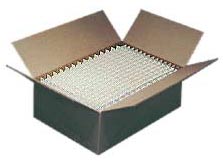Chipboard Stages a Retro-Revival for Itself
The humble and omnipresent material known as “chipboard,” or “particle board,” is making a comeback for itself in some unlikely, even fashionable, venues. Used in packaging and package partitioning since its inception (chipboard is one of the primary materials we use in our box partitioning here at M & M), as well as in scrapbooking and frame-building, chipboard is “making a comeback” as a vintage means of decorating everything from corporate office spaces to Brooklyn, Chicago, and East End London dive barsGoogle’s new research campus in London, for instance, relies heavily on chipboard for its new wall design. The chipboard is supposed to project a raw, urban, and grittily trend-setting image for the giant computer company. Since a vast number of Google’s employees are in their 20s and 30s, this atmosphere has been built in hopes of being “inspirational” to those who work there.
Additionally, chipboard is staging a retro-revival for itself in other urban settings, such as in trendy restaurants and bars. The Alibi, one of East London’s current hottest dance venues, is essentially a dive bar with walls entirely made of chipboard. In America, it’s catching on as well. Within our own Chicago city limits, one can see “chipboard chic” alive and well at new restaurants and pubs in Bucktown, Ukrainian Village, and Wicker Park. In Brooklyn, as well, the Williamsburg, East Williamsburg, and Bushwick neighborhoods have all developed a love for party-friendly particle board.
All of this is, of course, a passing phenomenon. Chipboard will continue to drive the packaging and partitioning industries in America and throughout the world. But as a reflection of the still considerable might (and storied history) of concentrated industry in cities, the grit and urban associative-ness of chipboard will continue to thrive, regardless of how it’s packaged.
Share this:
This entry was posted in: Uncategorized





